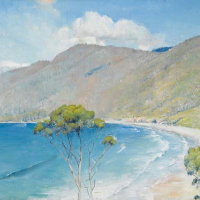15. TOM ROBERTS

The later paintings by Tom Roberts occupy a singular place in his career. In comparison to the famous '9 x 5s' painted early on in the artists career, and the great Shearing the Rams (1890) and Bailed Up (1895), his late paintings, mainly produced from about 1903 and in the last 30 years of his life, are generally modest in disposition, style, subject and size. In the past their ranking in Roberts oeuvre has been determined by a number of factors aside from their intrinsic merits and they have often been overlooked by critics and collectors.
Among the reasons for this was a widely held belief that Roberts had suffered a decline in his health and abilities around 1900, due to the strain of working on Opening of the First Parliament of the Commonwealth of Australia by H.R.H The Duke of Cornwall and York (Later H.M. King George V), May 9th, 1901. This painting, also known as The Big Picture was an awesome 3.0 x 5.0 m historical record of the event and included more than 100 portraits from life. It was meant to confirm Roberts standing as the premier portrait painter of the age and the crowning achievement of his career to date. Instead it marked, according to many observers, the end of his creative eminence1 and the later paintings seemed to be proof of this.
Lately however, these same late paintings have undergone something of a revival in positive critical opinion, if not a revolution. In his 1996 essay published on the occasion of the Art Gallery of South Australias exhibition Tom Roberts Retrospective2, Barry Pearce goes some way to redressing the imbalance; pointing out the injustices of earlier commentary and drawing attention to the merits and generally inviting a more positive appreciation of these paintings to the point where they emerged as a vital component of Roberts oeuvre, taking a rightful place amongst the best Australian art of their time.
Eaglehawk Neck, a previously unrecorded work which is signed and dated by the artist to 1925, is a very fine and typical example. Roberts wife was Tasmanian and he was in the habit of visiting the island for family reasons, as well as using it as the subject for his work. The painting depicts a stretch of the Tasman Peninsula in south-eastern Tasmania, 75km from Hobart. Anyone who has visited this place will be aware of numerous sights in the area: the well-known blow-hole, the narrow spit of land that connects the two parts of the Peninsula, the curious tidal rocks known as the Tessellated Pavement plus a number of other famous and very distinctive and spectacular geographic landmarks in the area. Yet Roberts seems to have pointedly selected a view that is comparatively banal; a steep hillside descending directly to the sea with a fine beach in the middle distance and two curiously truncated foreground trees. In comparison to mainstream landscape painting and even compared to the work of his well-known contemporaries Arthur Streeton (1867-1943), Sydney Long (1871-1953) and Hans Heysen (1877-1968), the painting is individualistic and discretely unconventional.
The paintings Roberts produced in the last years of his career also demonstrate a clear line of development and a fascinating point of comparison with numerous later artists, including Arthur Boyd (1920-1999), Fred Williams (1927-1982), William Robinson (born 1936) and Philip Wolfhagen (born 1963). Many of these painters acknowledge their debt to Roberts. When the artists own indebtedness to the earlier Louis Buvelot (1814-1888) is considered, and his pivotal role in the development of Australian landscape painting is considered, his title: Father of Australian Landscape Painting3 is confirmed.
Footnotes
1. Spate, V., Tom Roberts, Lansdowne Press, Melbourne, 1972 p.121
2. Pearce, B., Reflections on the Late Work, published in: Radford, R., Tom Roberts, Art Gallery of South Australia, Adelaide, 1996, pp.168-178
3. Croll, R.H., Tom Roberts - Father of Australian Landscape Painting, Robertson & Mullens Limited, Melbourne, 1935
Timothy Abdallah BA